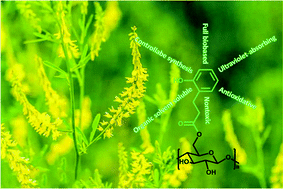Synthesis of a fully biobased cellulose-3-(2-hydroxyphenyl) propionate ester with antioxidant activity and UV-resistant properties by the DBU/CO2/DMSO solvent system†
Abstract
Recently, cellulose esters with particular functionality have obtained considerable attention as they can be used in various fields; therefore, the design and facile synthesis of cellulose esters is still a prime subject of research in this area. In this study, a novel cellulose derivative, namely cellulose-3-(2-hydroxyphenyl) propionate ester (CHP), was first prepared using cellulose and 3,4-dihydrocoumarin (DHC) in dimethylsulfoxide (DMSO)/1,8-diazabicyclo[5.4.0]undec-7-ene (DBU)/CO2, a newly developed cellulose solvent system, without adding any external catalyst. The effects of the reaction conditions on the substitution degree (DS), including DHC loading, reaction temperature and time, were systematically investigated, and the CHP with a DS of 2.35 could be prepared when the molar ratio of DHC to anhydroglucose units (AGU) was set at 6/1 at 120 °C in 3 h. The structures and thermal properties of the as-prepared CHP were fully elucidated by nuclear magnetic resonance spectroscopy (NMR), Fourier transform infrared (FT-IR) spectroscopy, differential scanning calorimetry (DSC), and thermal gravimetric analysis (TGA). The ultraviolet (UV) absorption properties and free radical scavenging ability were evaluated by UV-visible absorption spectroscopy and a well-developed 2,2-diphenyl-1-picrylhydrazyl (DPPH)-based colorimetric protocol. The CHPs were identified to have satisfactory UV absorption properties and antioxidant capacity, and the instant DPPH radical scavenging activity reached 68.1% to 100% in 30 min when 40 mM of CHP was applied at 25 °C. Kinetic studies demonstrated that the reaction followed a pseudo-first order reaction kinetic model, and the activation energy (Ea) and Arrhenius frequency factor (A) of CHP-3 to DPPH could be calculated to be 24.24 kJ mol−1 and 2.5918 s−1 by the Arrhenius equation, respectively. The cytotoxicity of the CHPs was also primary evaluated in L929 cells to identify the potential of CHPs for biomedical applications.



 Please wait while we load your content...
Please wait while we load your content...